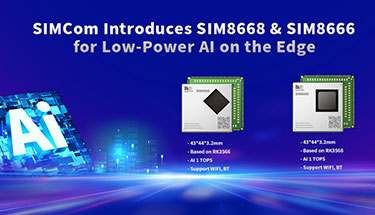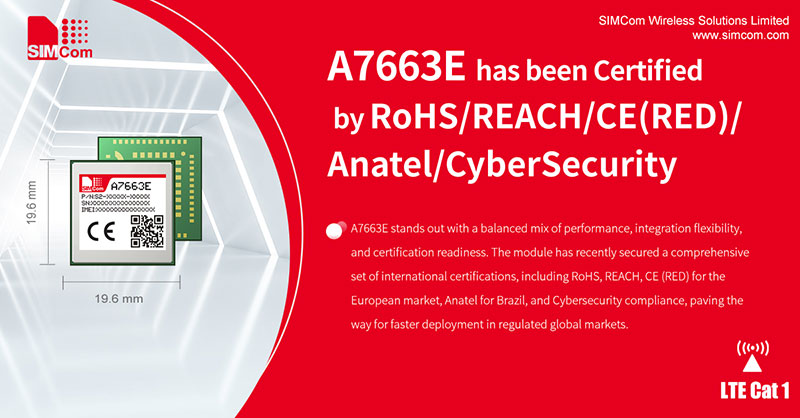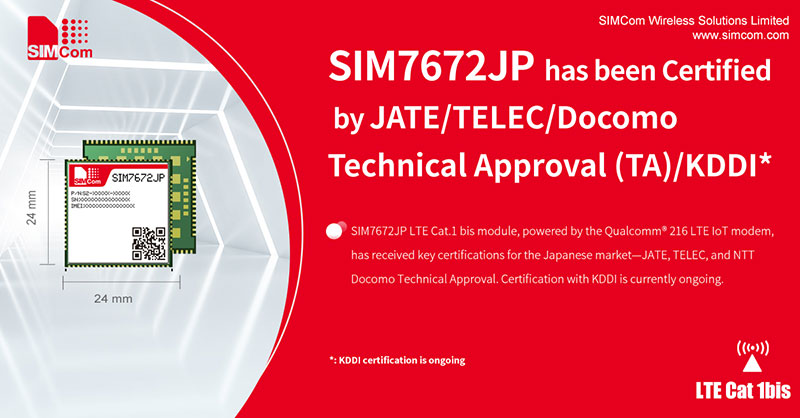- Ameya360 Component Supply Platform >
- Trade news >
- SIMCom Introduces SIM8668 & SIM8666 for Low-Power AI on the Edge
SIMCom Introduces SIM8668 & SIM8666 for Low-Power AI on the Edge

AI has clearly become a key focusacross industries at MWC Shanghai 2025. While high-level and advanced-levelAI computing modules are alreadyadopted in applications like video conferencing, AR/VR, edge computing, and industrial PDAs, the growing diversity of edge applications has created strong demand for entry-level AI solutions that prioritize low power consumption, cost-efficiency, and fast deployment.
To address the trends, and following the recent launches of its SIM9850 (high-level AI computing module) and SIM9630L-W (advanced-level AI module), SIMCom — a global leader in IoT communication solutions — has introduced two new entry-level AI computing modules: SIM8668 and SIM8666, designed to bring intelligent capabilities to lightweight, energy-efficient edge devices.
Powered by the RK3568 and RK3566 platforms, both SIM8668 and SIM8666 deliver 1 TOPS of NPU performance and come equipped with a wide range of interfaces—including LVDS, MIPI-DSI, HDMI 2.0, CSI, USB, PCIe, UART, SPI, I2C, and more. These interfaces allow easy connection to cameras, displays, audio, and sensors, enabling rich data collection and smooth human-machine interaction. The integrated NPU supports INT8/INT16 hybrid operations and is compatible with popular AI frameworks such as TensorFlow, PyTorch, MXNet, and Caffe, offering flexibility for deploying a variety of deep learning models.
These capabilities make SIM8668 and SIM8666 ideal for edge AI applications like like face recognition, license plate detection, seatbelt monitoring, people counting, helmet detection, e-bike identification, and safety alerts—all while maintaining low power consumption and cost efficiency for smart, connected devices.
Specifically, the SIM8668 features a 2.0GHz CPU, ARM Mali-G52 GPU, and an 8M ISP with HDR support. It also supports dual independent displays, suitable for advanced multimedia and multitasking needs. The SIM8666, on the other hand, is designed for cost-sensitive AI applications with a 1.8GHz CPU, the same Mali-G52 GPU, and support for single or mirrored dual display output. It also includes a touchscreen interface (I2C TP), offering enhanced flexibility for HMI (Human Machine Interface) scenarios in both consumer and industrial devices.
With their compact design and built-in connectivity, SIM8668 and SIM8666 help customers accelerate product development and reduce time-to-market.These modules are well suited for a variety of low-power edge AI applications, including home automation, self-service kiosks, digital signage, audio and video streaming devices, dashcams, and HMI systems.
By launching the SIM8668 and SIM8666 during MWC Shanghai, SIMCom demonstrates its continued commitment to expanding the accessibility of AI—offering practical, scalable solutions to enable smarter edge devices across a wider range of industries.
Online messageinquiry
- Week of hot material
- Material in short supply seckilling
| model | brand | Quote |
|---|---|---|
| RB751G-40T2R | ROHM Semiconductor | |
| CDZVT2R20B | ROHM Semiconductor | |
| BD71847AMWV-E2 | ROHM Semiconductor | |
| MC33074DR2G | onsemi | |
| TL431ACLPR | Texas Instruments |
| model | brand | To snap up |
|---|---|---|
| TPS63050YFFR | Texas Instruments | |
| ESR03EZPJ151 | ROHM Semiconductor | |
| IPZ40N04S5L4R8ATMA1 | Infineon Technologies | |
| BU33JA2MNVX-CTL | ROHM Semiconductor | |
| BP3621 | ROHM Semiconductor | |
| STM32F429IGT6 | STMicroelectronics |
Qr code of ameya360 official account
Identify TWO-DIMENSIONAL code, you can pay attention to


Please enter the verification code in the image below:


























